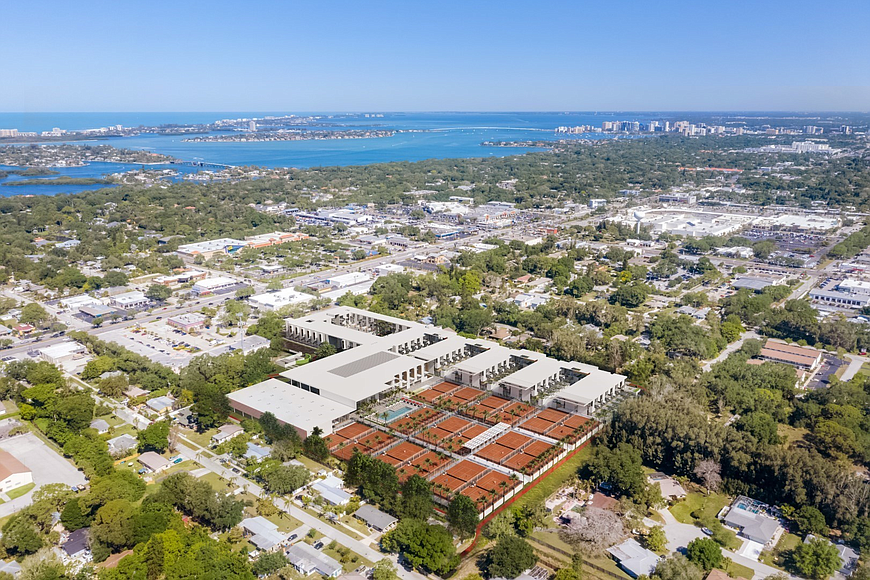- December 17, 2025
-
-
Loading

Loading

The City Commission determined a revised proposal to build up to 277 apartments on the site of the Bath and Racquet Club was in line with the city’s review standards, voting 4-1 on Monday in favor of a rezoning request to facilitate the project.
Although the prospective developer of the Bath and Racquet Club site had earned initial approval for a similar application in March, the project team returned to the commission Monday in pursuit of potential changes to the plans for the site at 2170 Robinhood St. Initially, the developer sought to build a mixed-use project with 207 residential units, a new fitness center, commercial space and office space.
One month after the commission approved that first application, the project team had filed a request to change its plans. Architect Michael Halflants said the project team was seeking flexibility to build up to 70 more apartments on the site, asking the city to authorize the addition of one residential unit for every 1,000 square feet of commercial space removed from the March proposal.
At Monday’s commission meeting, the revision drew opposition from nearby residents who objected to the increased residential density — and the process of approving a new proposal just four months after the last public hearing on redeveloping the Bath and Racquet site. Still, a majority of the board felt the application remained appropriate for the site.
“I simply don’t understand how adding residential harms a residential neighborhood,” Commissioner Liz Alpert said.
The commission’s vote served as an initial approval for a request to change the zoning classification of the site. That application must go through a second public hearing before the approval is finalized, and the developer is required to submit a site plan for review before the project is cleared to move forward.
Since April, residents neighboring the Bath and Racquet site — who have raised concerns about multiple iterations of redevelopment plans since 2017 — have criticized the proposal to increase the number of apartments. That line of criticism continued at Monday’s meeting, where speakers asserted the 277-unit plan was too much for the 13.4-acre property.
“This project really needs to be right-sized,” resident Ben Cannon said.
Halflants said the potential addition of more residences was a relatively minor change within the overall scope of development planned for the site. He also pushed back against the notion that more apartments made the project less compatible with neighboring homes, stating that swapping commercial space for residential space would decrease the number of vehicular trips the project generated.
“That reduces traffic, reduces parking load,” Halflants said.
Members of the public also questioned the commission’s decision to take up the revised application without sending it back to the Planning Board for further review. R.N. Collins, who appeared Monday as a representative for individuals living near the property, asserted the mixture of residences and a fitness club should not be permitted under the city’s land use designation for the site. He also contended the city used improper metrics to determine the traffic impact of the rezoning.
City staff said any site plan would be thoroughly reviewed to ensure compliance with applicable regulations, and Fournier said the traffic question could be settled at the second public hearing on the rezone application. Still, speakers remained skeptical about how officials were handling the application.
“This is a really irregular process,” Collins said.
Fournier said the commission had the authority to review the application itself rather than remanding the revised proposal to the Planning Board.
“If a majority of the commissioners believe that these modifications are understandable and do not require another recommendation from the Planning Board, then I think the commission is free to consider the revised application without sending it back,” Fournier said in a July 3 email.
Commissioner Jen Ahearn-Koch, who supported the March proposal, was the lone member of the board to voice concerns about the procedure associated with the new rezoning application. Without a finalized site plan, Ahearn-Koch said she did not believe she had enough information to determine if the proposal complied with the city’s review standards.
“For me, this is not the correct process,” Ahearn-Koch said.
The rest of the commission offered positive feedback on the proposal. Mayor Hagen Brody said he believed he would have approved the revised submittal if it had been the first application the commission had reviewed, and he disagreed with residents who suggested increased density was problematic in an urban setting.
“Density, when you’re looking at a city planning perspective, is a good thing,” Brody said. “You need density to get the things we need in this community — housing, affordability. Density is environmentally friendly.”
This article has been edited to correct Commissioner Jen Ahearn-Koch’s vote on the March rezoning application for the Bath and Racquet Club property.